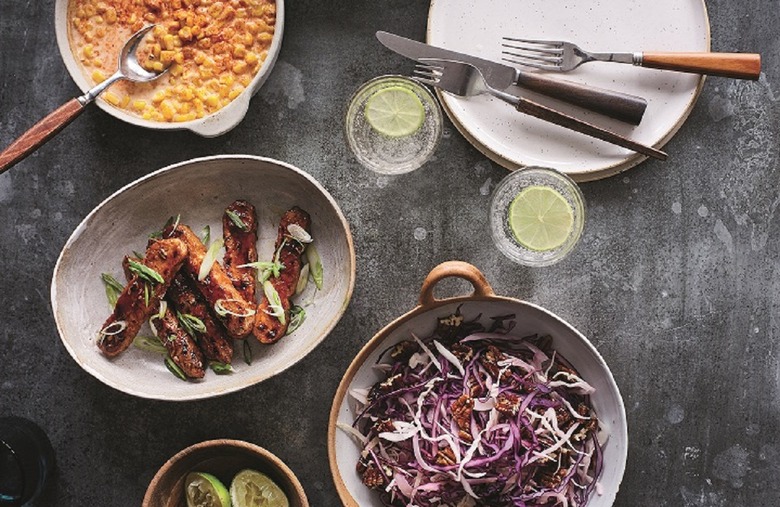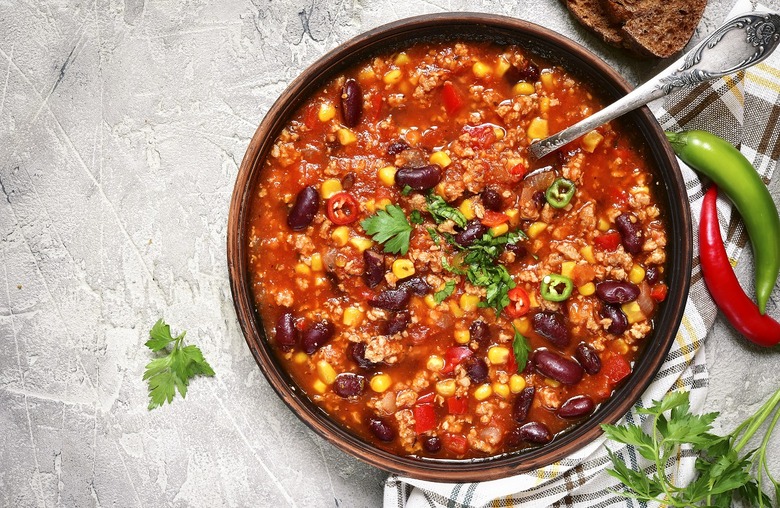Ingredient Spotlight: Tempeh (And 7 Tempeh Recipes)
We may receive a commission on purchases made from links.
If there is a single culinary buzzword to kick off the new year, "plant based" is it. But before there were lab-created, hyper-realistic meat substitutes like Beyond and Impossible, there was tempeh. The probiotic and protein-packed ingredient originated in Indonesia centuries ago and continues to be a staple there, but its demand in the United States has grown substantially in recent years. No longer relegated to health food stores and vegan restaurants, tempeh is poised to go mainstream. As veganism becomes increasingly popular, so do new and creative ways to live a plant-based lifestyle.
You're probably familiar with tofu, but if you're not enthusiastic about its consistency, or if you're looking for something a bit more flavorful, tempeh is a great alternative. If you don't know what tempeh is, let alone how to cook with it, we've got you covered whether you are vegan or simply looking to reduce your meat consumption for health or environmental reasons. Here's the rundown on everything you need to know about tempeh before you bring it home with you, plus seven awesome recipes to get you fired up in the kitchen.
What is tempeh?
If you're wondering what tempeh is made of, the confusion is understandable. While it is most commonly a soy product, tempeh can also be made from any number of beans and legumes. Here, we'll be referring to soy tempeh. The plant-based protein and meat substitute is most commonly made from boiled, fermented soybeans. While its cousin tofu is made from soy milk, tempeh is produced by boiling soaked and dehulled soybeans, then mixing them with a starter culture and leaving it to ferment for 24 hours (much like sourdough). If you're feeling industrious, you can even make DIY tempeh at home. The resulting product is firm yet moldable, making it a good option for meatless burgers and other plant-based meals.
What does tempeh taste like?
The fermentation process and use of whole soybeans give tempeh a subtle nutty, earthy flavor, which is far more distinct than tofu. Its texture is commonly described as somewhat meaty and chewy, similar to chicken or mushrooms. But cookbook author Nava Atlas says that neither of those comparisons really describe tempeh.
The writer of "Plant-Powered Protein: 125 Recipes for Using Today's Amazing Meat Alternatives," says that tempeh is an acquired taste. According to Atlas, because of its "distinct flavor and mouthfeel, tempeh may not be as endlessly versatile as tofu, but it's no slouch," adding, "if you take a liking to it, you'll find tempeh quite useful."
Where can you buy tempeh?
Until recently, tempeh was something you might only find in natural food stores or places like Trader Joe's or Whole Foods that stock plant-based options. But thanks to its increase in demand, tempeh can now easily be found in major supermarkets. Lightlife tempeh went from selling its product in 300 Walmart locations to 3,500 late last year, while Maple Leaf Foods plans to spend a staggering $100 million to ramp up its tempeh production.
What are the health benefits of tempeh?
There are a multitude of health benefits associated with tempeh. In addition to being high in fiber and protein and cholesterol free, tempeh is also packed with essential vitamins and minerals. Because of the fermentation process, which breaks down complex proteins, tempeh is rich in probiotics and thus easier to digest than non-fermented soy products; this makes it an excellent food for gut health and for an anti-inflammatory diet. Studies have even shown that the meat substitute can decrease the risk of heart disease and strokes, as well as cancer and osteoporosis.
Tempeh vs. tofu
Tofu and tempeh are two popular plant-based proteins, but they differ in a few notable ways. As mentioned before, tofu is made from soy milk while tempeh is made from cooked soybeans. Because of this, tempeh is considered to be less processed than tofu, and has a very different taste and texture. Tofu is plain and has a bouncy, spongy texture, while tempeh is firm and chewy and has a nutty, earthy taste. Tofu is often considered an excellent blank slate for other flavors.
Tempeh and tofu also have different nutritional profiles. Aside from being easier to digest because it's fermented, tempeh has two times as much protein as tofu. Three and a half ounces of tempeh has 19 grams of protein, while that same serving of tofu only has 9 grams. But both tempeh and tofu are excellent ingredients to have in your plant-based arsenal.
How to store tempeh
According to Lauren Toyota, author of "hot for food all day," once tempeh is "sauced, seasoned and cooked, it will last a few days in a container in the fridge." For first-time buyers, Toyota notes that you shouldn't be shocked by any black spots on tempeh. She explained that because tempeh is a fermented food, a little discoloration is normal.
Packages of tempeh usually contain only two to four servings, so Toyota says that you shouldn't worry about having a lot left over. The cookbook author uses tempeh on salads, bowls and pastas for up to four days after cooking.
Although tempeh has the most flavor when it's fresh, it can last in the freezer for up to three months. If you're planning to freeze tempeh longer than that, it's recommended that you parboil it to kill off the mold. To do so, put a tempeh cake in boiling water and let it simmer for about five minutes. Drain the water, then slice the tempeh long ways into half-inch-thick slices and store it in the freezer in sealed bags for up to three months.
How to prepare tempeh
Whereas tofu can be eaten uncooked, tempeh must be cooked in order to kill off any unwanted mold that may have fermented along with the good stuff (just check the package; if it says "fully cooked," you're good to go).
Beyond that, how you prepare tempeh depends on the particular recipe you plan to use it in, according to Ian Theasby and Henry David Firth, authors of "Speedy BOSH!: Quick. Easy. All Plants." The BOSH.tv stars say to start by cutting the block of tempeh into your desired shape.
"For example, you may want long thin slices if you're recreating bacon, thick batons if you're recreating chicken, or cubes if you're recreating chunks of pork," they say.
Once the tempeh is cut, you should steam it for a couple of minutes, which allows it to cook evenly and soak up more of the flavor, while also reducing any potential bitterness.
When it comes to seasoning tempeh, Toyota says it's "really no different than when you season meat." According to the cookbook author, "the flavor of any cooked meat usually comes from the fat and the spices and herbs, so you can apply that same technique to vegetables, tofu and of course, tempeh." She recommends thinking about the flavor profiles you'd follow when cooking meat and sticking to them. If you're using tempeh as a substitute for chicken, for example, you shouldn't veer away from traditional chicken seasonings, like rosemary, thyme, lemon, salt and pepper.
Types of tempeh recipes
Tempeh works well in a variety of different recipes. You can use it in sandwiches, tacos, chili and more. Atlas says one of her favorite ways to use tempeh is by turning it into a plant-based chorizo, which "makes an excellent taco filling or pasta topping" (see recipe below). You can also use the chorizo as filling for a stew or chili.
On the other hand, Toyota prefers to cook tempeh in a way that allows its natural texture and structure to stay intact. For this reason, she's a fan of using tempeh as bacon crumbles (see recipe below) for adding to dishes like vegan carbonara and bacon kale pasta. Scroll on for some sensational tempeh recipes that are as good for tempeh beginners as they are for connoisseurs, and as approachable for vegans as they are for the veg-curious.
Recipes that use tempeh
BBQ Tempeh Ribs
One way Theasby and Firth like to use tempeh is by turning it into "ribs." To do so, blanch the tempeh in boiling water for about three minutes, then coat it in a BBQ sauce, red wine vinegar, fennel seed and salt mixture and broil it for about five minutes. This recipe from "Speedy Bosh" will make you forget that tempeh is completely vegan.
Teriyaki Tempeh
Teriyaki tempeh, another recipe from Theasby and Firth, adds a Japanese-inspired spin to the Indonesian soy product. To ensure the tempeh soaks up the flavor of the sweet sauce, blanch or steam it for about five minutes before cooking.
Tempeh Bacon Chunks
As previously mentioned, one of Toyota's favorite ways to use tempeh is by turning it into bacon chunks. Liquid smoke, which is used in this recipe, is a quick and easy way to add a smoky, meaty flavor to plant-based products. Break the tempeh into small pieces and bake it for about 30 minutes to ensure it gets nice and crisp.
Filet-o-Tempeh Sandwich
Craving fast food is common whether you're plant-based or a carnivore. But this recipe from Toyota's cookbook will put those cravings to rest. Filet-o-Tempeh gives a vegan twist to a fast food favorite. Top the beer-battered tempeh with vegan tartar sauce and serve on a bun.
Tempeh Breakfast Sausage Patties
Tempeh's firm structure makes it the perfect meat substitute for molding into burgers, sausage patties and more. This recipe from Atlas' cookbook adds tempeh to a food processor with oats, ketchup, maple syrup, barbecue seasoning and more. The mixture is molded into sausage patties and fried to perfection.
For the Tempeh Breakfast Sausage Patties recipe, click here.
Tempeh and Mushroom Chorizo
Chorizo is a spicy, crumbled sausage that's popular in Mexican cooking, but it's quite easy to make using plant-based alternatives. Here, Atlas adds tempeh to a food processor to mimic the texture of chorizo. When flavored with paprika and chili powder, it makes for the perfect addition to tacos, pasta and more.
Tempeh and Walnut Ground
This tempeh and walnut ground (think ground beef, minus the beef) will give you a punch of protein. After being pulsed in the food processor, the ground is best served as a way to thicken up a hearty bowl of vegan chili. But, if you're new to the plant-based world and still easing into things, these vegetarian dinner recipes are easy, affordable and far from intimidating.
For the Tempeh and Walnut Ground recipe, click here.
More from The Daily Meal:
How to Use Food Scraps to Make Delicious Meals
Mocktail Recipes Everyone Will Love
Got New Kitchen Gadgets For Christmas? Here's What to Make First
4-Ingredient Entrees Perfect for Busy Weeknights
Tribune Publishing may earn a commission if you purchase a product through one of our links.






